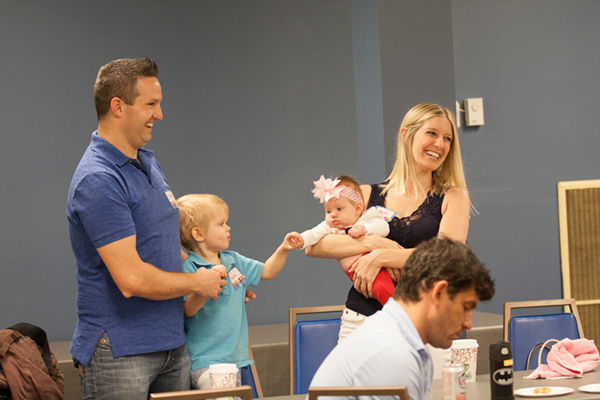ADL initiative starts anti-bias education early on
Published September 21, 2016
As Matt Golliver daubed various paints together, he was still trying to get his skin tone just right.
“I think I’m getting a little bit closer but there is still some work to do,” said the Creve Coeur resident as he mixed fleshy hues into a single coherent pigment.
Afterward, facilitator Anyta Wilson summed up the work that Golliver and about a dozen other families were doing.
“This art project makes us understand color is really complicated,” she said.
That could have been the theme for Sunday’s entire event at Temple Israel, where parents and young children gathered to learn more about anti-bias education thanks to the Miller Early Childhood Initiative of the Anti-Defamation League’s A World of Difference Institute.
The meeting was the fourth in a series hosted by TI, with the other sessions focusing on parents and teachers.
This one was meant for families. Golliver, a TI member, was there with his wife and two children.
“We are here as a family to teach our kids about diversity so we know how to approach conversations when our kids start asking us about people and their differences,” he said.
That was part of the impetus for bringing the program to TI’s Deutsch Early Childhood Center.
Leslie Wolf, director of education for the center, said she had been inspired to look into ADL’s offerings when someone mentioned a recent incident in a department store.
“Initially, a parent came to me about a year and a half ago. They were in Target and her son noticed a child whose skin was very dark and made this really loud comment, ‘Hey, mommy, look how dark that little boy’s skin is,’” recalled Wolf.
The mother didn’t know how to respond. Wolf said that she began doing research and found that the Miller initiative was designed for just such questions.
Wilson told the group that the natural tendency to shush the child or act as though the question was inappropriate is the wrong response, however well-intentioned.
“If that’s one of the ways that you respond because you are uncomfortable with that conversation, your child will start to notice. Even if they don’t know what is making you uncomfortable they will start to notice maybe I’m not supposed to talk about that,” she said. “Maybe it is a bad thing that person is different and I shouldn’t like people like that.”
Wilson said that children begin picking up on physical differences related to gender and race as early as age 2 or 3.
“More importantly by two or three, children are already starting to show signs of bias that they’ve picked up from their environment,” she said. “Most of us think that we are amazing human beings and we would never go out of our way to hurt anybody because we’re good people. However, we often don’t think about the things we’ve soaked up in our lives and how we might be dribbling it out in places where we don’t actually mean for it to come out.”
Instead, Wilson recommended finding healthy ways to address the issue early in a proactive manner.
“We don’t want to leave them to put together what that all means by themselves and with their friends for five years until they get to third grade,” she said. “We don’t need you feeling confused, overwhelmed and scared about ‘How do I answer my kids’ questions?’”
To illustrate her points, Wilson engaged the group in a variety of activities including using paint to represent skin color, and pointing out different ways to greet people in multiple languages. Participants also were encouraged to work in small groups discussing the origin of family names with their youngster.
Attendees were able to take home a booklet of resource materials describing everything from the importance of exposing children to diversity to the best ways to choose toys and books that combat bias.
“We think it is a great opportunity for our families and our kids to learn about differences and to answer questions they may have about things going on in our community and our world,” said Alana Minoff, vice president of the parents committee at Deutsch. “I hope they learn to be better people and to be more welcoming and accommodating to people who may not look like them.”
Lisa Moons, a TI congregant, hoped her 4-year-old daughter Ilana would find the experience rewarding as well.
“I’m hoping she’ll gain a perspective that there are people who have different skin color, have different gender, who are different religions but we are all contributing, respectful members of our society,” she said. “We want to do everything we can to encourage her to get along with everyone and be inclusive.”
















